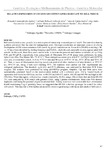Please use this identifier to cite or link to this item:
http://www.alice.cnptia.embrapa.br/alice/handle/doc/1066096| Title: | Relative expression of CRy10 in GM cotton lines resistant to boll weevil. |
| Authors: | SANTOS, R. C. dos  SILVA, C. R. C. da   SOARES, T. da C   CAVALCANTI, J. J. V.   LIMA, L. M. de   MARTINS, E. S.   PONTES, R. G. M. S. de   |
| Affiliation: | ROSEANE CAVALCANTI DOS SANTOS, CNPA; CARLIANE REBECA COELHO da SILVA, UFRPE; TAÍZA da CUNHA SOARES, UFRPE; JOSE JAIME VASCONCELOS CAVALCANTI, CNPA; LIZIANE MARIA DE LIMA, CNPA; ÉRICA SOARES MARTINS, Cenargen; ROSE GOMES MONNERAT SOLON DE PONTES, Cenargen. |
| Date Issued: | 2016 |
| Citation: | In: ENCONTRO DE GENÉTICA DO NORDESTE, 21., 2016, Recife. Anais... Ribeirão Preto: SBG; Recife: UFPE: UFRPE: UPE, 2016. p. 87. |
| Description: | Boll weevil (Anthonomus grandis) is a serious pest of cotton crop in several parts of world. The control is done by synthetic pesticides that increase the management costs. Embrapa coordinates an important research involving development of GM cotton resistant to boll weevil, by genetic transformation. Seven line (T0-8H) containing a Btcry 10 have been identified by feeding bioassays and ELISA, which showed reasonable toxicity against adult boll weevils. In this work, these lines were used in order to estimate the presence and relative expression of cry 10 by PCR and RT-qPCR, respectively, from young buds of 50d-plants. RT-qPCR assays were performed, by using Syber Green Rox Plus Master Mix 2X (LGC). Three endogenous cotton gene (GhACT, GhUBQ14 and GhPP2A) were used as a standard control. At first, 95°C/15 min and 40 cycles of 95°C/ 20 sec, 60°C/ 20 sec and 72°C/ 20 sec. Then, a curve of denaturation (melting curve) was performed after conclusion of amplification, at 95°C/15 sec, 60°C/15 sec, rising 2°/min until reaching 95°C. All reactions were carried out with experimental and biological replications. The threshold cycle (Ct) and PCR efficiency was estimated by Real-time PCR Miner program. The analyses were performed by using qBASEPlus program. Graphics, Cqs and Melt curve were automatically generated, based on the normalization method with a reference gene, ??Cq. Varied levels of expression were found in GM lines, too low in 8H-269 and 8H-357, mid in 8H-282 and 8H-346 and high in 8H- 336 (14x). These data agreed with previous results obtained by ELISA assays. Eleven lines derivate from 8H-336 (T1) were analyzed by PCR assays with genomic DNA, using 2 primer combinations. More than 50% showed amplicons confirming the presence of gene in selected lines. Taking in account that a reasonable level of resistance should overcoming 2 ug of protein/g tissue, we suggested that 8H-366 is the best genotype for control the cotton boll weevil. This material will be further advanced for entomological assays with larvae and adults of boll weevil. |
| Thesagro: | Anthonomus Grandis Algodão Bicudo |
| NAL Thesaurus: | Cotton |
| Keywords: | Boll weevil |
| Type of Material: | Resumo em anais e proceedings |
| Access: | openAccess |
| Appears in Collections: | Resumo em anais de congresso (CNPA)  |
Files in This Item:
| File | Description | Size | Format | |
|---|---|---|---|---|
| RelativeexpressionofCry10.pdf | 107,21 kB | Adobe PDF |  View/Open |









